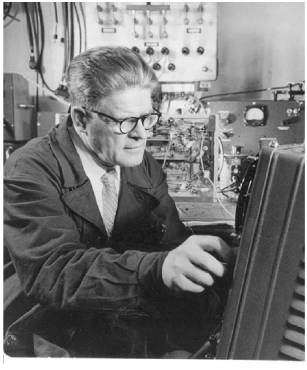Cherenkov Light Detectorscos θ = 1/βn |
 Павел Алексеевич Черенков 1904 - 1990 |
Cherenkov Light Detectorscos θ = 1/βn |
 Павел Алексеевич Черенков 1904 - 1990 |
where θ is the angle, β is the velocity of the particle relative to the speed of light in a vacuum (β = v/c), and n is the index of refraction of the medium through which the particle is passing. Unaware of Heaviside's theory, in 1937 Cherenkov and Vavilov working in Russia discovered the radiation this radiation while studying nuclear decay. A year later their co-workers Frank & Tamm had come up with an adequate theoretical explanation as well. Unfortunately for non Russian speakers like myself, most of the early research on the subject was published in Soviet journals.
A more detailed look at the theory (under construction - comments are welcome!)
J. V. Jelley, Čherenkov Radiation and Its Applications, (1958).
V. P. Zrelov, Cherenkov Radiation in High-Energy Physics, (1970).
Cosmotron/AGS Cherenkov Counters:
S. J. Lindenbaum et al, Nucl. Instr. Meth. 20, 256 (1963).
Belle's ACC:
T. Iijima et al, Nucl. Instr. and Meth. in Phys. Res. A 453, 321 (2000).
KEDR's ATC:
KEDR's ACC homepage
BLAST's Cherenkov Detectors:
BLAST Cherenkov Counter Homepage
B. Tongue et al, Nucl. Instr. Meth. Phys. Res. A 553, 364 (2005).
A historical survey of ring imaging Cherenkov counters - J. Seguinot and T. Ypsilantis (1994)
Theory of ring imaging Cherenkov counters - T. Ypsilantis and J. Seguinot (1994)
Cherenkov Detectors in Particle Physics - This presentation traces the history of Cherenkov detectors from the first ideas of Seguinot and Ypsilantis to RICH detector to the CRID to ACCs to the DIRC to prototypes of future detectors. Special emphasis is given to the DIRC detector at BaBar, with which the presenter has personal experience. (given to the Spaniergruppe at UT August 2006).
RICH conferences - 1993, 1995, 1998, 2002, 2004, 2007
Ring Imaging at the Cosmotron:
G. T. Reynolds et al, Nucl. Instr. Meth. 20, 267 (1963).
DELPHI's RICH detector:
RICH detector homepage
The ring imaging Cherenkov detector of DELPHI - W. Adam et al, Nucl. Instr. and Meth. in Phys. Res. A 343, 68 (1994).
SLD's CRID:
Performance of the CRID at SLD - K. Abe et al, Nucl. Instr. and Meth. in Phys. Res. A 343, 74 (1994).
BaBar's DIRC:
a robust PID system invented by Blair Ratcliff for B-factories
my DIRC page
BaBar DIRC homepage
I. Adam et al, Nucl. Instr. and Meth. in Phys. Res. A 538, 281 (2005). - the main paper on the DIRC
CLEO's LiF-TEA:
1 cm thick LiF radiator coupled to MWPCs using methane and TEA.
CLEO Collaboration Homepage
Performance - R. Sia, Nucl. Instr. Meth. Phys. Res. A 553, 323 (2005).
PHENIX's RICH:
Detector description - Y. Akiba et al, Nucl. Instr. Meth. Phys. Res. A 453, 279 (2000).
LHCb's RICH:
LHCb RICH homepage
ALICE's HMPID:
The High Momentum Particle Identification Detector
ALICE HMPID Homepage
R&D for the Future:
Focusing DIRC at SLAC - similar to the BaBar DIRC, but with a spherical mirror to focus the light in the stand-off box.
A. Y. Barnyakov et al, Nucl. Instr. Meth. Phys. Res. A 553, 70 (2005). - on a focusing Aerogel RICH detector which uses six layers with different refractive indices to focus the Cherenkov radiation.
First predicted by Gurgen Askaryan in 1962, but not detected until the end of the century after his death, the "Askaryan Effect" has so far been observed in 3 radiotransparent substances.
The Askaryan Effect in Silica Sand
hep-ex/0011001
The Askaryan Effect in Rock Salt
astro-ph/0412128
The Askaryan Effect in Ice
hep-ex/0611008
The ANITA experiment will fly long-wavelength EM detectors on a balloon over polar ice to look for neutrino interactions with the ice. It has also been proposed to launch a lunar satellite to use the moon as a Cherenkov radiator since the regolith is radio transparent.
1888 - Heaviside predicts radiation of particles moving faster than the speed of light in any medium, including the aether.
1936 - Cherenkov & Vasilov discover the radiation.
1937 - Frank & Tamm come up with a successful theory of Cherenkov radiation.
1952 - Cherenkov Counter starts taking data at the Cosmotron.
1963 - Cherenkov rings imaged at the Cosmotron by Reynolds et al.
1977 - Seguinot & Ypsilantis come up with the idea for a ring-imaging detector of Cherenkov radiation.
1989 to 2000 - DELPHI's RICH takes data.
1991 to 1998 - SLD's CRID takes data.
1999 to present - BaBar's DIRC takes data on B-mesons.
1999 to present - CLEO uses the LiF-TEA detector to study heavy b and c quarks' decays.
2000 to present - PHENIX's RICH takes data.
2002 to present - BLAST's Cherenkov detectors take data.
2006 - ANITA observes Askaryan effect in ice.
Physics Acronyms |
Return to the top, or back to my homepage.